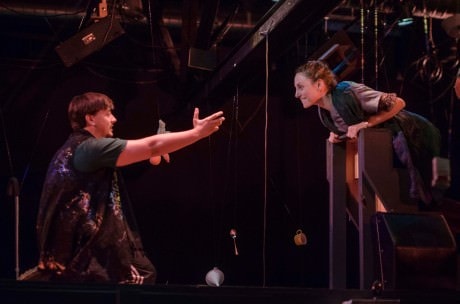There are 8,670 hours in one year. Burnt food has a sad taste. Despite the title, the show will start at 7:30PM. The end of the world can be a very personal thing. In true Single Carrot Theatre fashion, the final show of their 7th season is emotionally evocative, confusing, dangerously inventive, loaded with conjecture, and full of wondrously stunning moments that make no sense whatsoever but make you really think. The Apocalypse Comes at 6PM, a new work written by Georgi Gospodinov, is making its National Premier in the Carrots’ new home up on North Howard Street here in Baltimore. Directed by Genevieve de Mahy, this ensemble piece at its core answers to the company’s mission statement of creating vibrant new theatrical experiences that are socially significant.

The versatility of the SCT space alone is reason enough to come see the production; much like fingerprints no two shows will ever have the same layout. On par for the course, Set Designer Lisi Stoessel has created a visually stunning set splayed out across a tennis court seating arrangement. Stoessel blends reality with absurdism, symbolism flowing into actuality and back again with the miscellaneous hanging objects suspended above and around the main set structure. Stoessel’s construct of cubby’s that flank either end of the set create a place for the characters to rest and exist outside of their action in the production while remaining potentially active in view of the audience. The main structure itself in a sense is like a cross-section; seeing through the compartments of life from all angles while simultaneously creating a fixture for which the main character— and later others— can climb. Stoessel’s structure, in a way, becomes representative of a playground apparatus; the main narrator who turns the characters into his puppets and toys, climbing all over it to tell his tale as a child might when recounting a fond or unpleasant memory while at recess.
Lighting and Sound are spared no extravagance in this production, as designers Kel Millionie and Steven Krigel making an ever present blend of the two that are strangely fitting to the work that unfolds before the audience’s eyes. The absence of light in Millionie’s design at the beginning creates an effect of pandemonium, while the warm glows of sunset colors at the end of show brings the surreal dreamlike state to a close in bliss. Krigel enhances these moments in darkness and light with unusually serene musical interludes; an eerily calming presence for the end of the world.
Director Genevieve de Mahy conceptualizes the production through a tightly focused lens. It becomes a story about telling stories; the main character listed only as The Accordionist (Paul Diem) develops several stories whose significance to one another is mostly irrelevant until they begin to intertwine in unsteady and uncertain fashions. It is de Mahy’s ability to guide this ensemble through the production that makes this piece a truly group-focused work; at times even Diem’s character shifts out of focus so that other segments of the story gain importance.
The acting all round is exceptional. The plot, however, is convoluted. There is room for great interpretation and conjecture all throughout the performance; many layers and levels of symbolic representation that don’t necessarily connect with one another and bits of the story feels jumbled, perhaps lost in translation from its original language. This, however, should not discourage anyone from going to see it. The story is not linear; nor should it have to be to impact the audience as it does and if nothing else it will conclude leaving many great opportunities for discussion, debate, and questions in general.
Diem’s performance as the main storyteller/narrator figure is well-grounded in this animated persona he has created. His body is lively; an extension of his words as he recounts his first murder at age nine— among other instances. This main story is one of the only times he speaks directly to the audience as the rest of the show is spent silently “controlling” the other characters with gestures. He calls them into play, dismisses them from the scene, and even loses control of them up to a point.

Jack Sossman gives a stunning performance when he becomes an antagonizing force fighting against Diem. A scene late in the performance incorporates an exhausting chase all around the set structure where Sossman has become a source of narration and Diem desperately attempts to quiet him by catching him. In this moment Sossman embodies a repressed childhood memory that simply will not retreat into the recesses of Diem’s mind; a truly compelling moment in the production between the two performers.
The female performer of note, occasionally referred to as ‘Tina,’ is Isa Guitian. Silently watching with childlike naivette and fascinated interest, she is forever on the outside of the story. There is a striking moment when Guitian truly exists outside of the entire experience; but for fear of spoiling its splendor that is all that can be said on the matter. It is intriguing to watch her watching the action of the other characters; investing in the way she sees the story and in a sense making you see what she sees.
The remaining ensemble— featuring Alix Fenhagen, Larry Levinson, Sèamus Miller, Lois Sanders, and Mike Zemarel— are equally compelling for the parts they play, but referencing specifics may only lead to confusion. Simply come and see the show to enjoy their performances and formulate your own opinions of how they fit into the story that might be the end of the world.
Forcing you to think both inside and outside the box, and perhaps wonder if there is a box at all; The Apocalypse Comes at 6PM is great nourishment for your brain.
Running Time: 1 hour and 45 minutes, with no intermission.
The Apocalypse Comes at 6PM plays through June 29, 2014 at Single Carrot Theatre— 2600 North. Howard Street in Baltimore, MD. For tickets, call the box office at (443) 844-9253, or purchase them online.




